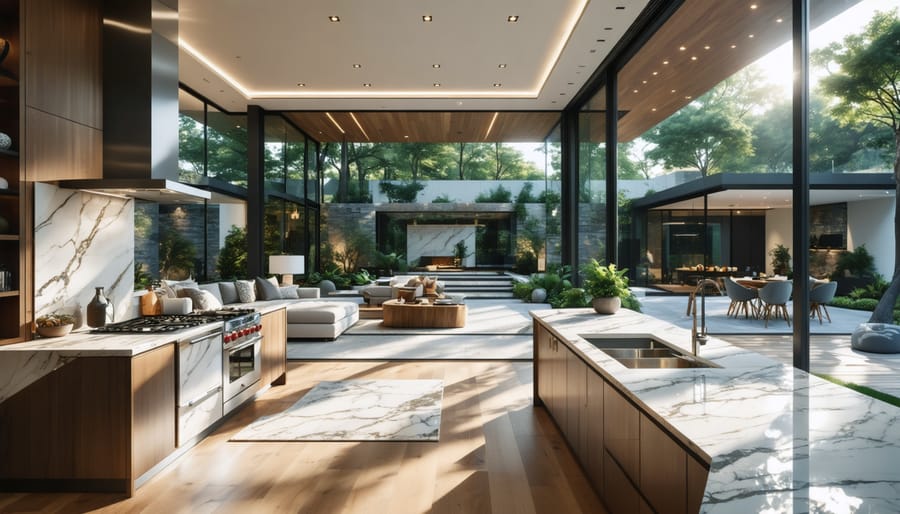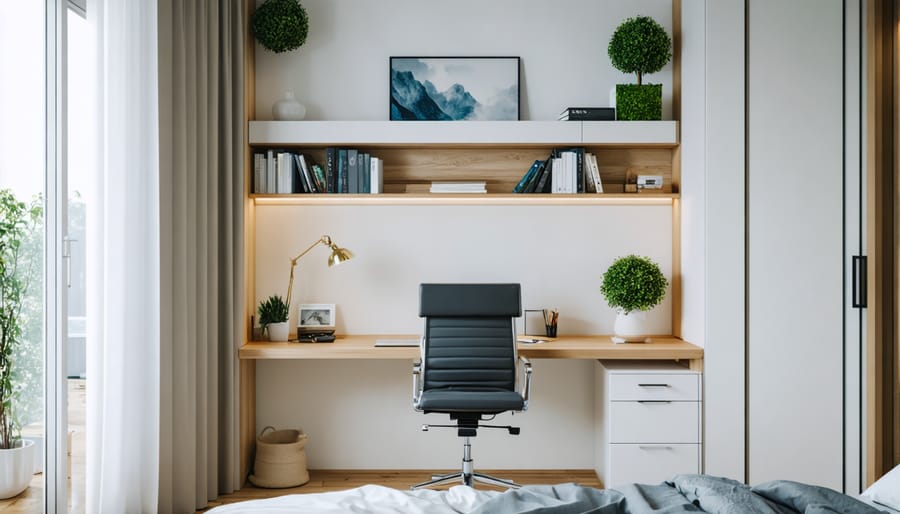Choose light, cool hues like pale blues, greens, and grays to visually expand your small bedroom, as these colors make rooms look bigger by reflecting more light. Stick to a monochromatic color scheme, using different shades of the same color, to create a cohesive and spacious feel without overwhelming the eye. Opt for an eggshell or satin finish to further enhance light reflection while maintaining a soft, inviting atmosphere in your cozy sanctuary.
How Paint Color Affects a Small Bedroom
The color of paint you choose for a small bedroom can have a significant impact on how the space feels. Lighter colors, such as white, cream, and soft pastels, tend to reflect more light and make a room feel more open and airy. These colors can help create the illusion of a larger space by visually expanding the walls. On the other hand, darker colors absorb light, which can make a small room feel even smaller and more enclosed. However, deep rich colors can also add depth and a cozy, intimate feel to a small bedroom when used strategically.
In addition to the lightness or darkness of a color, its temperature and undertones also affect the ambiance of a room. Cool colors like blues, greens, and purples tend to recede and can make a space feel calmer and more relaxing. Warm colors such as reds, oranges, and yellows advance and can energize a room, but may feel overwhelming in a small space if used too extensively.
Undertones, the subtle hues beneath the main color, can also influence the overall vibe. For example, a white with cool blue undertones will feel crisp and fresh, while a white with warm yellow undertones will create a softer, cozier atmosphere. By understanding these basic principles of color theory and considering the desired mood for your small bedroom, you can select a paint color that enhances the space and makes it feel more welcoming and comfortable.


The 9 Best Paint Colors for Small Bedrooms
1. Soft White
Soft white paint is a classic choice for small bedrooms, as it creates a bright, airy atmosphere that visually expands the space. This neutral hue reflects light, making the room feel more open and inviting. Soft white also serves as a versatile backdrop, allowing you to easily incorporate accent colors through bedding, curtains, and décor. When selecting the perfect soft white, consider options with subtle undertones to enhance the room’s ambiance. For a crisp, clean look, opt for a pure white like Benjamin Moore’s Chantilly Lace or Sherwin-Williams’ Extra White. If you prefer a warmer, creamier feel, try Behr’s Swiss Coffee or Farrow & Ball’s White Tie. These timeless soft white paints will transform your small bedroom into a serene and spacious retreat.

2. Pale Gray
Pale gray is a sophisticated alternative to stark white that keeps a small bedroom feeling bright and airy while adding a touch of depth. The cool undertones of light gray create a soothing atmosphere, making the space appear more expansive. For a crisp, clean look, consider a barely-there gray like Sherwin-Williams Olympus White or Benjamin Moore Classic Gray. If you prefer a slightly warmer hue, Behr’s Silver Drop or Valspar’s Opal Glass offer a delicate balance of gray and beige. These pale gray shades reflect light beautifully, visually opening up the room without compromising on style and character.
3. Blissful Blue
Pale blue hues are a go-to choice for small bedrooms, as they create a serene and expansive atmosphere. These calming shades reflect light, making the room feel airier and more spacious. For a tranquil retreat, consider soft blues like Benjamin Moore’s “Breath of Fresh Air,” Sherwin-Williams’ “Sea Salt,” or Behr’s “Light French Gray.” These barely-there blues have a soothing effect and pair beautifully with crisp white trim and natural wood accents. To add a touch of sophistication, opt for a slightly grayer blue like Farrow & Ball’s “Borrowed Light” or Valspar’s “Serenity Blue.” With pale blues, your small bedroom will become a peaceful haven for rest and relaxation.
4. Gentle Green
Bring the serenity of nature into your small bedroom with gentle green hues. Sage greens and muted olives create a calming, restful atmosphere that makes the space feel more expansive. These earthy tones pair beautifully with natural materials like wood and linen, enhancing the room’s tranquility. For a soft, soothing vibe, try Benjamin Moore’s “Sage Wisdom” or Sherwin-Williams’ “Svelte Sage.” If you prefer a slightly deeper, more sophisticated look, opt for Farrow & Ball’s “Olive” or Behr’s “Sage Green.” These gentle greens evoke a sense of harmony and balance, transforming your small bedroom into a peaceful retreat.
5. Creamy Yellow
Soft, buttery yellows can lend a warm, sunny glow to a small bedroom, making it feel cozy and inviting. These creamy shades evoke the gentle warmth of sunshine filtering through curtains on a lazy morning. When selecting a yellow for your small space, opt for pale, muted tones rather than bright, saturated hues to avoid overwhelming the room. Farrow & Ball’s Dayroom Yellow or Sherwin-Williams’ Friendly Yellow are excellent choices that bring a soft, buttery warmth without feeling too bold. Pair these soothing yellows with crisp white trim and natural wood accents to create a space that feels like a warm, welcoming retreat.
6. Blush Pink
Soft, blush pink hues can create a soothing and romantic ambiance in a small bedroom. These light pinks have a calming effect and can make the room feel cozy and inviting. Opt for a barely-there pink like Farrow & Ball’s Setting Plaster or Benjamin Moore’s First Light for a subtle, sophisticated look. For a slightly brighter blush, try Sherwin-Williams’ Charming Pink or Behr’s Pink Blossom. These delicate pinks pair beautifully with white trim and light wood furnishings, adding a touch of femininity without overwhelming the space. Blush pink is also versatile enough to complement various decorating styles, from vintage to modern.
7. Lavender Mist
Soft lavender and lilac hues can transform a small bedroom into a dreamy, restful retreat. These soothing colors evoke a sense of calm and serenity, perfect for unwinding after a long day. Lavender Mist by Sherwin-Williams is a lovely choice, with its gentle purple undertones that create a relaxing atmosphere. Benjamin Moore’s Misty Lilac is another beautiful option, offering a slightly cooler tone that pairs well with crisp white accents. When using lavender in a small space, consider balancing it with neutral elements like gray or beige to maintain a light and airy feel. With the right lavender shade, your small bedroom will become a tranquil oasis for rest and rejuvenation.
8. Beachy Taupe
Beachy taupe shades bring the calming essence of sandy shores into your small bedroom, creating an open and airy atmosphere. Light taupe colors like Sherwin-Williams’ “Sand Dollar” or Benjamin Moore’s “Muslin” have warm undertones that evoke feelings of relaxation and tranquility. These soft neutrals reflect light beautifully, visually expanding the space while providing a versatile backdrop for coastal-inspired decor. Pair taupe walls with crisp white trim and natural textures like linen and jute for a serene, beach-house vibe that makes your small bedroom feel like a soothing retreat.
9. Barely-There Greige
Greige, a subtle blend of gray and beige, can modernize a small bedroom while keeping it cozy and inviting. This on-trend hue adds depth and sophistication without overwhelming the space. For a warm, earthy greige, consider Sherwin-Williams’ Accessible Beige or Agreeable Gray. If you prefer a cooler tone, try Benjamin Moore’s Revere Pewter or Edgecomb Gray. These versatile neutrals pair beautifully with a wide range of accent colors and decor styles, making them perfect for creating a serene and stylish retreat in your small bedroom. Embrace the barely-there greige trend to make your space feel contemporary and welcoming.
Factors to Consider When Choosing a Paint Color
When selecting a paint color for your small bedroom, consider your existing decor colors to ensure a cohesive look. Take into account the color of your furniture, bedding, curtains, and any artwork or accessories. You want your paint choice to complement these elements, not clash with them.
Natural light plays a significant role in how paint colors appear in a room. If your small bedroom receives plenty of sunlight, you can explore a wider range of colors. However, if your room has limited natural light, opt for lighter shades to enhance the brightness and avoid making the space feel cramped.
Color psychology is another essential factor. Different colors evoke various emotions and can impact the overall atmosphere of your bedroom. For a calming and relaxing vibe, consider cool tones like blue, green, or lavender. If you want to create a cozy home decor feel, warm colors such as soft yellow or pale pink can be inviting.
Lastly, think about the purpose of your small bedroom. Is it a master bedroom, a guest room, or a child’s room? The function of the space can guide your color choice. For example, a master bedroom may benefit from soothing neutrals, while a child’s room can handle more playful and vibrant hues.
Remember, the best colors for hallways and connecting spaces should also be taken into account to create a seamless flow throughout your home.
Painting Tips for Small Bedrooms
When painting a small bedroom, opt for light-reflecting finishes like satin or semi-gloss to bounce light around the room and create a brighter, more open feel. Consider painting vertical stripes to draw the eye upward and visually expand the space. For an accent wall, choose a slightly darker shade of your main color to add depth without overwhelming the room. Use painter’s tape to ensure crisp, clean lines and prevent any mishaps. Don’t forget to properly prep the room by covering furniture, filling holes, and sanding rough spots for a smooth, professional finish. With the right techniques and a well-chosen color palette, you can transform your small bedroom into a cozy, inviting retreat. Remember, the principles you use when painting a small bedroom can also be applied when designing the perfect workspace to maximize comfort and productivity in a compact area.
Conclusion
In conclusion, choosing the right paint color for your small bedroom can make a world of difference in creating a spacious, inviting atmosphere. From soothing neutrals like white, gray, and beige to calming blues and greens, there are countless options to suit your personal style and make your room feel larger. Don’t be afraid to experiment with lighter shades of your favorite colors, like lavender or pale yellow, to add personality without overwhelming the space. Remember to consider the amount of natural light your room receives and test samples before committing to a color. With these tips in mind, you’re well on your way to transforming your small bedroom into a beautiful, comfortable sanctuary that you’ll love spending time in.





